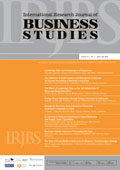Article Metrics |
|
|
The X-Efficiency of Shariah and Conventional Banking’s in Indonesia
Abstract
This paper investigates the X-efficiency of fifteen commercial banks in Indonesia consisting of seven syariah banks and eight conventional banks. This study uses three stages of data analysis: non-parametric data envelopment analysis (DEA) approach, t-test, and multiple regression method. The results show that in the period of this study, both syariah and conventional banks in Indonesia have not reached the optimal level of efficiency. However, conventional banks obtain a higher level of allocative and total efficiency compared to syariah banks. The inefficiency of Islamic banks is stemed from allocative inefficiency rather than technical problems. The bank’s X-efficiency is significantly influenced by size, rather than number of banking channels and staff costs. This study provides important implications for syariah banking in order to improve X- efficiency and compete in the banking industry in Indonesia by focusing on the improvement of the combination of quality assets.
Keywords: X-efficiency, DEA, Shariah and conventional banks
* Universitas Negeri Padang, Jl. Prof. Dr. Hamka, Air Tawar Bar., Kec. Padang Utara, Kota Padang, Sumatera Barat 25171
Full Text:
References
Amirillah, M. A. (2010). Efisiensi Perbankan Syariah di Indonesia Tahun 2005-2009. Doctoral dissertation: Universitas
Diponegoro.
Bank Indonesia. (2011). Statistik Perbankan Syariah. Jakarta
Bank Indonesia. (2015). Statistik Perbankan Syariah. Jakarta
Berger, A. N., & Humphrey, D. B. (1991). The dominance of inefficiencies over scale and
product mix economies in banking. Journal of Monetary Economics, 28(1), 117-148.
Charnes, A., W. Cooper, and E. Rhoades (1978) Measuring Efficiency of Decision Making Units. European Journal of
Operational Research 2, 429–44
Firdaus, M. F., & Hosen, M. N. (2013). Efisiensi Bank Umum Syariah Menggunakan Pendekatan Two-Stage Data Envelopment
Analysis. Buletin Ekonomi Moneter dan Perbankan, October
Hadad, M.D, M.JB. Hall, K. Kenjegalieva, W. Santoso, R. Satria and R. Simper (2008). Efficiency in Indonesian Banking : Recent
Evidence. Departement of Economics Loughborough University Working Paper 13
Hassan, Kabir M. (2006). The X-Efficiency in Islamic Banking. Islamic Economic Studies 13(2)
Ika, Siti Rochmah Ika, Abdullah , Norhayati. (2011). A Comparative Study of Financial Performance of Islamic Banks and
Conventional Banks in Indonesia. International Journal of Business and Social Science 2 (15)
Komaryatin, N. (2006). Analisis Efisiensi Teknis Industri BPR di Eks Karesidenan Pati. Doctoral dissertation, Program
Pascasarjana Universitas Diponegoro.
Leibenstein, H. (1966). Allocative efficiency vs.» X-efficiency». The American Economic Review, 392-415.
Lovell Knox, C.A. (1993) Production Frontiers and Productive Efficiency, in The measurement of productive efficiency :
Techniques and applications,ed. Fried, H.O., Knox Lovell, C.A., Schmidt, S. S., Oxford University Press, 1993
Maudos, Joaquin, Pastor Jose M, Perez, Francisco, Quesada, Javier (2002). Cost and profit efficiency in European banks.
Journal of International Financial Markets, Institutions and Money 12, 33-58
Nunamaker, T. R. (1985) Using Data Envelopment Analysis to Measure the Efficiency of Non-Profit Organisations: A Critical
Evaluation. Managerial and Decision Economics 6: 1, 50–58.
Sarker, M.A.A.(1999). Islamic Banking in Bangladesh: Performance, Problems and Prospects. International Journal of Islamic
Financial Services 1
Sathye, M. (2001). X-efficiency in Australian banking: An empirical investigation. Journal of Banking & Finance, 25(3), 613-630.
Soteriou, A., and S. Zenios (1998) Data Envelopment Analysis: An Introduction and Application to Bank Branch Performance
Assessment. In G. Marcoulides (ed.) Modern Methods for Business Research. London: Lawrence Erlbaum Associates.
p. 136.
Yudistira, Donsyah. (2004). Efficiency in Islamic Banking : An Empirical Analysis of Eighteen Banks. Islamic Economic Studies
(1)
Copyright (c) 2020 INTERNATIONAL RESEARCH JOURNAL OF BUSINESS STUDIES
International Research Journal of Business Studies has been covered by the following services: | ||||||||||||||||||||||||
|




















